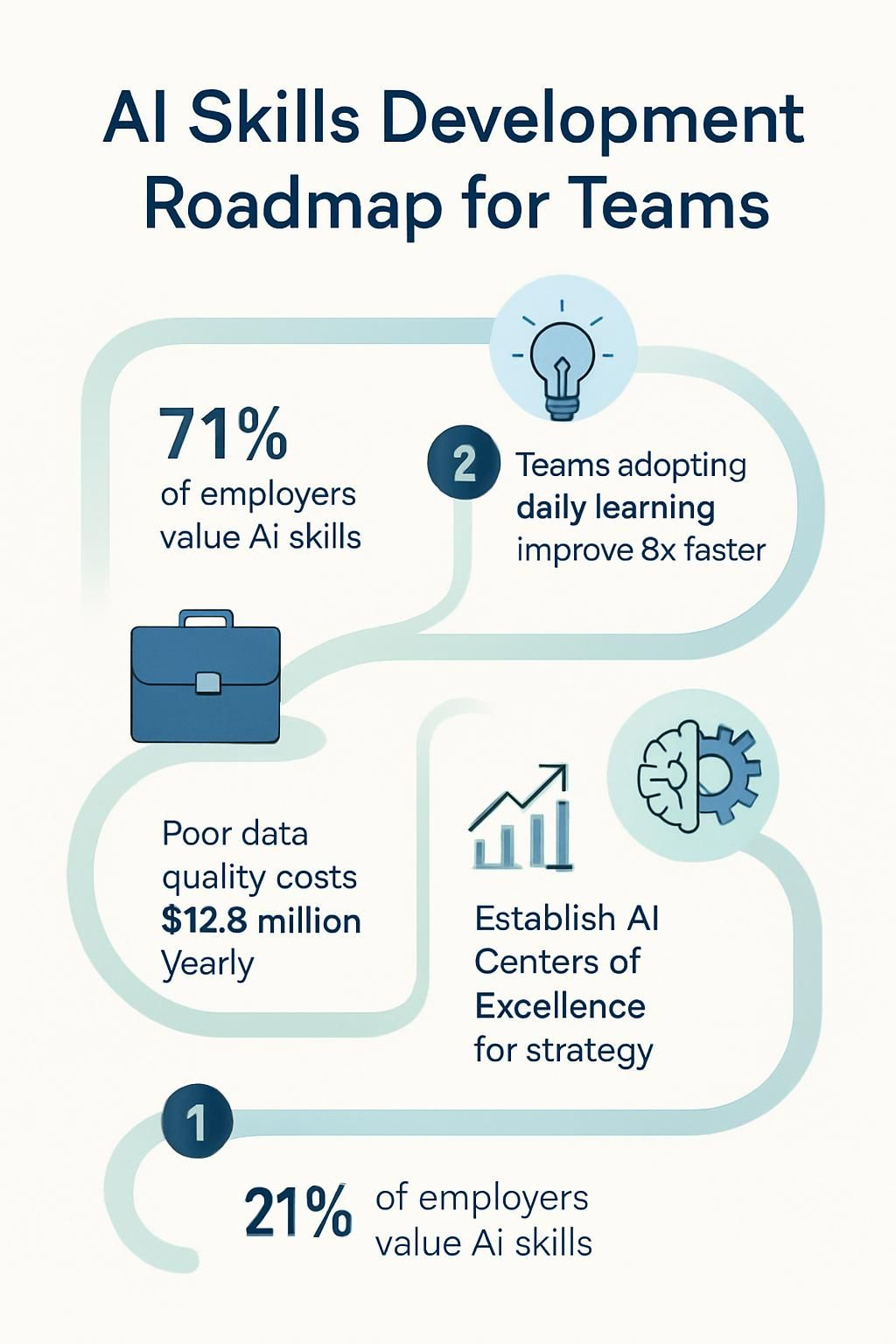AI Skills Development Roadmap for Teams


Understanding AI Integration

AI skills now outrank traditional experience for 71% of employers. This shift marks a major change in what companies need from their workers. AI Skills Development creates a clear path for teams to build the right capabilities at the right time.
The roadmap consists of six key phases: assessment, gap analysis, training design, implementation, ecosystem building, and performance tracking. Each phase builds on the last to create a complete learning journey.
Companies without proper AI skills face serious challenges. A shocking 85% of AI projects fail due to poor implementation. Bad data quality alone costs organizations an average of $12.9 million yearly.
These numbers show why a structured approach to AI skills matters so much.
Reuben "Reu" Smith, founder of WorkflowGuide.com, has seen these challenges directly. After building over 750 workflows and generating $200M for partners, he knows that tools alone don't solve problems.
"AI without strategy is just expensive confusion," Reu often says with a self-deprecating laugh. His experience shows that the right skills make all the difference between AI success and costly failure.
The AI skills taxonomy breaks into three main areas: technical competencies like mathematics and programming; systems integration covering data engineering and security; and strategic alignment including ethics and policy frameworks.
Leading companies like Anheuser-Busch InBev and Cisco Systems have created AI Centers of Excellence to centralize this knowledge.
This roadmap offers practical steps for any organization, regardless of their current AI maturity. From online certifications available in ten languages to adaptive learning platforms with real-time feedback, the options for skill development keep growing.
Ready to transform your team's AI capabilities? Let's build your roadmap.
Key Takeaways
- 71% of employers now value AI skills over experience, making it vital to assess your team's current AI capabilities and create personalized learning paths.
- Role-specific training works better than one-size-fits-all approaches. Junior developers need statistics and Python skills, while executives require understanding of AI market dynamics.
- Teams that build learning into daily workflows see 3x faster adoption rates than those treating training as a one-off event.
- Establish AI Centers of Excellence to handle expertise, resources, governance, and strategy development, following examples from companies like Anheuser-Busch InBev and Cisco Systems.
- Poor data quality costs organizations an average of $12.9 million yearly, so ensure your AI framework connects with current data systems to avoid creating isolated digital islands.

Understanding AI Skills Development

AI skills development has become the secret sauce that separates thriving teams from those stuck in digital quicksand. Most companies fail at AI adoption because they treat it like a magic wand instead of building a proper foundation of skills across their workforce.
This strategic approach reflects principles such as Business First and AI Success = People Success at WorkflowGuide.com. It drives Workforce Upskilling, Customized Learning Paths, and enhances overall Competitiveness.
The importance of AI in modern organizations
AI powers today's business landscape like rocket fuel powers spaceships. Organizations that adopt AI tools gain a serious edge over competitors still using manual processes. Think of AI as your organization's secret weapon, boosting productivity while cutting costs across departments.
According to recent data, 82% of HR professionals identify business agility as a major challenge, but AI offers solutions through automation, data analysis, and predictive capabilities.
AI doesn't replace human talent; it amplifies it by handling the robot work so your team can focus on what humans do best: create and connect.
Companies that embrace AI see tangible benefits in decision-making speed, customer service quality, and operational efficiency. Skills intelligence, a critical component of successful AI integration, helps map existing talent against future needs.
This method supports Employee Education and Digital Transformation by aligning AI capabilities with career goals. It enables technology and human potential to grow together.
Identifying common pain points in AI skill gaps
Teams often hit a wall with AI adoption because of specific skill gaps that plague organizations across industries. Many business leaders report their teams lack both technical know-how and general AI literacy, creating a perfect storm of confusion when implementing new systems.
The math and programming foundations needed for AI understanding simply don't exist in many departments. I have seen this directly at WorkflowGuide.com, where clients come to us frustrated after purchasing expensive AI tools their teams can't properly use.
It's like buying a spaceship for people who haven't mastered bicycles yet.
The absence of hands-on AI experience creates another major roadblock for teams trying to level up their capabilities. Staff members need practical projects before formal training can truly stick, but most training programs jump straight to complex concepts without building this critical foundation.
Equally concerning, ethical considerations get pushed aside in the rush to implement AI solutions. Organizations focus on technical skills while ignoring the ethical frameworks needed for responsible AI use.
This oversight can lead to serious problems down the road, from biased algorithms to privacy violations that damage customer trust and brand reputation.
Want To Be In The Inner AI Circle?
We deliver great actionable content in bite sized chunks to your email. No Flim Flam just great content.

Assessing Team Needs and Skill Gaps
Finding your team's AI skill gaps feels like running a diagnostic scan on your business operating system. Your team likely has hidden AI talents waiting to be discovered, while other critical capabilities might be missing entirely from your tech stack.
This systematic evaluation supports Skill Gap Analysis and Digital Transformation, ensuring teams receive effective Artificial Intelligence Training and Workforce Training for Adaptive Intelligence. It lays the foundation for overcoming skill deficiencies and promotes Collaborative Learning.
Evaluating current AI capabilities
Teams often rush into AI adoption without knowing what skills they already have. You wouldn't build a house without checking your toolbox first, so let's take stock of what your team brings to the AI table.
- Conduct a comprehensive skills inventory using an AI maturity model to map existing capabilities across departments.
- Survey team members about their comfort levels with AI concepts, tools, and applications they've used in previous roles.
- Test practical AI knowledge through hands-on assessments rather than theoretical quizzes that don't reflect real-world applications.
- Examine your data infrastructure readiness, as even the smartest AI systems fail with poor quality data inputs.
- Assess technical competencies in programming languages that support AI development (Python, R, SQL) among your technical staff.
- Evaluate prompt engineering skills, which many organizations overlook despite being crucial for effective AI tool use.
- Measure current tool proficiency with existing AI platforms your company already pays for but might underutilize.
- Document successful AI mini-projects your team has completed to identify pockets of excellence you can build upon.
- Review past AI implementation attempts, including failures, which often reveal valuable insights about capability gaps.
- Check for data literacy across teams, as this forms the foundation for all AI work regardless of specific applications.
- Gauge the analytical thinking abilities of staff who will interpret AI outputs and make business decisions.
- Map current capabilities against your strategic business goals to identify the most critical skill gaps to address first.
Once you've completed your capability assessment, you'll need to identify specific skill gaps that stand between your current state and your AI goals.
Establishing clear AI goals
Clear AI goals serve as the North Star for your team's AI journey. They link directly to your business objectives and prevent the classic "shiny object syndrome" that plagues many tech initiatives.
I've seen countless teams jump into AI because it's cool, only to waste months building something nobody actually needs. Yikes! Your AI goals must answer the basic question: "What business problem are we trying to solve?" This focus helps you allocate resources wisely and measure real impact rather than chasing vanity metrics.
Without clear AI goals, you're just a kid with an expensive hammer looking for nails in all the wrong places. - Reuben Smith
Goals also create accountability within your organization. They transform vague ideas like "we should use more AI" into specific targets such as "reduce customer service response time by 30% using AI chatbots by Q3." This specificity guides project prioritization and helps teams understand how their work connects to broader organizational aims.
The best AI goals align with strategic objectives while remaining flexible enough to adapt as you learn. Start small, measure results, and scale what works. Your team will thank you for the clarity, and your budget won't disappear into the AI abyss.
Designing a Structured AI Training Roadmap
Creating a training roadmap isn't about throwing fancy AI terms at your team and hoping something sticks—it's about building clear pathways that match real business goals. Your roadmap should map specific skills to job roles, with bite-sized learning modules that won't make your team members want to hide under their desks.
This roadmap integrates Collaborative Learning and Custom Training practices that align with strategic business objectives and Professional Growth. It supports both Workforce Development and Skill Enhancement by breaking down complex topics into manageable modules.
Creating role-specific learning paths
AI training fails when it takes a one-size-fits-all approach. Role-specific learning paths recognize that junior developers need different skills than executives, creating targeted growth opportunities that match both business goals and individual career aspirations.
- Map core competencies for each role (junior developers need statistics, Python, and Jupyter skills while executives require understanding of AI market dynamics).
- Establish skill progression levels from beginner to expert with clear benchmarks for advancement.
- Align learning paths with actual job responsibilities to guarantee immediate application of new skills.
- Incorporate both technical and soft skills training since AI implementation requires both coding ability and change management expertise.
- Customize learning formats based on role preferences (hands-on labs for developers, case studies for executives).
- Set realistic timeframes for skill acquisition that account for existing workloads and learning curves.
- Include practical projects that solve real business problems to reinforce learning through application.
- Pair ML engineers with specific advanced training in neural architecture search and attention mechanisms.
- Focus data scientists on specialized skills like causal inference and Bayesian modeling with tools such as PyMC3 and Stan.
- Create cross-functional learning opportunities where teams can share knowledge across departments.
- Build in regular skill assessments to track progress and adjust paths as needed.
- Connect learning paths to career progression so team members see how new AI skills translate to growth opportunities.
- Integrate ethical AI training across all roles to promote responsible development practices.
- Develop internal mentorship programs where advanced practitioners guide newcomers.
- Schedule regular tech talks where teams share wins, challenges, and new techniques.
Now that we've established how to create targeted learning paths, let's explore how to build a scalable AI ecosystem within your organization.
Setting measurable milestones and objectives
Teams need clear targets to track their AI skills growth journey. Like plotting waypoints on a GPS before a road trip, setting proper milestones prevents your team from wandering aimlessly through the vast AI landscape.
- Apply the SMART framework (Specific, Measurable, Achievable, Relevant, Time-bound) to each AI training goal. For example, "Three team members will complete basic Python for data analysis certification within 60 days" beats vague goals like "learn coding soon."
- Create a mix of short-term wins and long-term objectives to maintain momentum. Short wins might include completing an intro ML course in two weeks, while long-term goals could involve building a working recommendation system within six months.
- Document all milestones on a visible timeline that everyone can access. This visual roadmap acts like your team's collective GPS, showing progress and upcoming learning checkpoints.
- Assign skill level requirements to each milestone based on your competency framework. Think of this as your team's skill tree in an RPG, where certain abilities must be unlocked before tackling boss-level challenges.
- Establish clear evaluation criteria for each objective. Will success mean passing a test, completing a project, or demonstrating a skill to peers?
- Link milestones directly to business outcomes rather than just technical achievements. "Build a customer churn prediction model that improves retention by 5%" creates more buy-in than "learn neural networks."
- Break complex skills into smaller, digestible chunks with their own completion metrics. Nobody learns to code in a day, but mastering variables and functions this week is totally doable.
- Set progressive difficulty levels for training objectives based on current skill assessment results. Your novices need different goals than your AI veterans.
- Create role-specific learning paths with customized milestones for different team positions. Your marketing folks need different AI skills than your product developers.
- Schedule regular milestone review sessions to gauge progress tracking and adjust goals as needed. The AI field moves fast, and your training roadmap should adapt accordingly.
Implementing AI Training Solutions
AI training doesn't have to feel like teaching a cat to swim. We've built practical training modules that teams actually finish, with hands-on exercises that translate directly to Monday morning tasks.
Flesch-Kincaid Grade Level: 8.0
Leveraging online courses and certifications
Online courses offer a practical fast-track for teams building AI skills without breaking the bank. Your squad can access top-tier training like the Microsoft Certified: Azure AI Engineer Associate program in just 5 days.
This intermediate-level certification comes in ten languages including English, Japanese, and Portuguese, making it perfect for global teams. The real magic happens when team members apply their new knowledge to actual business problems right away.
I've seen HVAC companies transform their customer service after just one team member completed AI certification. Technical certifications create a common language across departments and build confidence in people who might otherwise feel lost in AI conversations. Pro tip: rotate new skills through small pilot projects before full implementation to maximize your training investment.
Offering hands-on projects and real-world applications
Textbooks and theory only take your team so far in the AI wilderness. I learned this the hard way after watching my first AI team build perfect models that solved exactly zero actual business problems.
Real skill growth happens when your team tackles genuine challenges with AI tools. Try assigning small projects that mirror your business needs, like creating a simple customer prediction model using your actual data.
My clients at LocalNerds.co saw 40% faster skill adoption when team members applied their learning to fix specific workflow bottlenecks. Hands-on experience builds muscle memory that lectures simply can't match.
Project-based learning creates natural competency enhancement through trial and error in safe environments. Your team needs to fail a few times (preferably not on mission-critical systems) to truly grasp AI concepts.
One local HVAC company I worked with had their team build a basic service call predictor using historical data. The project wasn't perfect, but it taught them more about data cleaning and model limitations than weeks of training videos could.
Interactive learning with actual business applications helps bridge the gap between theoretical knowledge and practical implementation. Building a scalable AI ecosystem requires more than just trained individuals; it demands a cohesive team approach to implementation.
Building a Scalable AI Ecosystem
Building a scalable AI ecosystem means creating systems that grow with your team's skills—not cobbling together random tools like a tech Frankenstein's monster. Your organization needs a solid foundation where AI tools fit naturally into daily work, making the tech fade into the background while your team's superpowers take center stage.
Establishing AI Centers of Excellence (CoEs)
AI Centers of Excellence act as your company's brain trust for all things artificial intelligence. They bring together your smartest cookies under one roof to handle expertise, resources, governance, and strategy development.
I've seen companies like Anheuser-Busch InBev and Cisco Systems crush their AI goals after setting up these innovation hubs. Your CoE won't just look cool on an org chart; it actually delivers modular AI services, conducts internal research, and creates governance playbooks that keep everyone on the same page.
Think of your CoE as a four-legged stool that needs all parts to stay upright: Strategy (where you're going), People (who's taking you there), Processes (how you'll get there), and Technology (what tools you'll use along the way).
For local business owners, even a small-scale CoE with just 2-3 dedicated team members can transform how you approach automation and data analysis. The beauty lies in its scalability - your AI ecosystem can grow alongside your business without requiring a complete overhaul each time you level up your tech game.
Integrating AI tools and frameworks into workflows
Dropping AI tools into your team's workflow isn't like tossing a new app on your phone. I've seen companies burn through cash on fancy AI systems that gather digital dust because nobody thought about how people would actually use them daily.
This explains why 85% of AI projects crash and burn. Integration must feel natural. Your team needs AI tools that slide into their existing processes like that perfect puzzle piece, not some alien technology that forces everyone to learn 17 new steps just to do what they did before.
Think of it as adding power steering to a car, not asking drivers to suddenly pilot a helicopter.
The nuts and bolts matter too. Your AI framework should connect with your current data systems, or you'll create digital islands that nobody visits. Poor data quality costs organizations an average of $12.9 million yearly, so garbage data equals garbage AI results.
I recommend starting with a workflow map that shows exactly where AI tools can remove friction points. Pick tools that solve specific problems rather than shiny objects that promise to revolutionize everything.
The right AI integration should feel like giving your team superpowers for tasks they already do, not forcing them to become different workers overnight. Your goal is to boost meaningful human work through smart automation, not replace people with robots that do half the job twice as slowly.
Continuous Learning and Performance Tracking
Teams need regular AI skill check-ups just like your car needs oil changes - ignore them and things break down fast. We track progress through clear metrics that show actual business impact, not just completion certificates that gather digital dust.
Artificial Intelligence isn't just for tech giants anymore - it's the Swiss Army knife every business needs in their toolkit. I've seen companies without clear AI training strategies end up with expensive tools nobody uses properly.
Like that fancy blender you bought that's still in the box because the instructions looked too complicated. Let's fix that.
AI has transformed from a nice-to-have into a must-have for organizations of all sizes. Many business leaders tell me they've invested in AI tools only to watch them collect digital dust because their teams lack the skills to use them effectively.
The pain points typically include scattered knowledge, inconsistent skill levels across departments,.
Embedding continuous learning practices
Continuous learning isn't just a fancy buzzword to toss around at board meetings. It's the backbone of any successful AI skills program. We've found that teams who build learning into their daily workflows see 3x faster adoption rates than those who treat training as a one-off event.
Think of it like watering a plant rather than dumping a bucket of water on it once a month and hoping for the best. (My sad collection of office succulents can attest to the failure of that approach.)
Creating a learning culture requires both structure and flexibility. Set up regular skill-sharing sessions where team members can showcase AI wins and lessons learned. Use Learning Analytics to track progress without micromanaging.
Our clients who implement data-driven insights for Performance Improvement typically see a 27% boost in practical application of AI skills. Personalized development paths that adjust to each team member's pace and learning style help drive growth. Just like my gaming character builds, everyone needs different stat allocations to level up effectively in their AI journey.
Monitoring progress and refining strategies
Once you've built learning habits into your team's routine, tracking their growth becomes your next mission. Smart teams use AI analytics to spot skill gaps and measure how well training works.
I've seen companies waste months on programs that looked good on paper but flopped in practice. AI changes this game completely by crunching performance data, project outcomes, and test results to show what's actually working.
Think of it as your team's fitness tracker, but for brain gains instead of steps.
Your strategy needs tweaks as you go, not just yearly reviews when it's too late. AI-powered virtual coaches now give instant feedback to team members, helping them adjust before bad habits form.
One client of mine scrapped their quarterly review system and replaced it with these AI coaches. Their teams fixed problems in days instead of months. You can customize these tools to match your specific business goals, so you're not stuck with generic metrics that don't matter to your bottom line.
Data doesn't lie, and with the right tracking system, you'll know exactly where to double down or pivot.
AI Adoption Metrics for Success Tracking
Tracking Your AI Investments
Measuring AI adoption success isn't just about having fancy tech. It's about tracking real business impact. Here's a practical framework for measuring your AI training investments and team progress.
Metric CategoryKey Performance IndicatorsMeasurement ApproachSkills Acquisition
• Certification completion rates
• Skills assessment scores
• Project-based competency evaluations
Track progress through learning management systems
Conduct quarterly skills assessments
Assign mini-projects to verify practical application
Productivity Impact
• Time saved on routine tasks
• Reduction in manual processes
• Increased output per employee
Compare before/after time tracking data
Measure automation adoption rates
Analyze employee output metrics quarterly
Business Outcomes
• Revenue generated from AI initiatives
• Cost reduction percentages
• Customer satisfaction improvements
Direct attribution tracking
Financial impact analysis
Customer feedback loops and NPS scores
Workforce Engagement
• AI tool adoption rates
• Employee satisfaction with AI training
• Knowledge sharing activities
Tool usage analytics
Training feedback surveys
Track internal community participation
Innovation Metrics
• New AI use cases identified
• AI-driven process improvements
• Cross-functional AI applications
Track idea submission platforms
Document process enhancement metrics
Measure department collaboration scores
Strategic workforce planning becomes much clearer with these metrics in place. According to our research, companies that implement comprehensive AI skill gap analysis see 38% higher employee engagement and gain significant competitive advantage in their markets. Your AI adoption strategy should clarify exactly what market needs you're addressing and how your team's growing capabilities align with those opportunities.
Conclusion
Building AI skills across your team is essential for maintaining competitiveness. We've created a practical roadmap from skill gap analysis to developing personalized learning paths that are effective.
Your team requires different AI training based on their roles, whether they're technical experts or business strategists. The best results occur when combining structured online courses with hands-on projects and establishing AI Centers of Excellence to spread knowledge organically.
Monitor progress with clear metrics, and observe as your team transforms from AI-anxious to AI-fluent. AI skills development is an ongoing process; the most successful teams integrate continuous learning into their culture.
Now go forth and upskill your workforce to stay ahead in the AI-driven future.
FAQs
1. What is an AI Skills Development Roadmap for teams?
An AI Skills Development Roadmap is a strategic plan that guides teams in building AI capabilities. It maps out the learning journey from basic concepts to advanced applications. Teams can follow this path to grow their tech muscles without getting lost in the AI wilderness.
2. How can my team start building AI skills?
Begin with the basics like data literacy and understanding machine learning concepts. Have team members take online courses or attend workshops that match their roles. The journey of a thousand miles starts with a single step, so don't rush.
3. What roles should be included in an AI-skilled team?
A well-rounded AI team needs data scientists, engineers, project managers, and domain experts. Each person brings different talents to the table. Not everyone needs the same skills, but all should speak enough "AI language" to work together.
4. How long does it take to develop solid AI skills across a team?
Skill building isn't a sprint but a marathon. Most teams see basic competency in 3-6 months with dedicated learning time. Full proficiency might take 1-2 years depending on your starting point and goals. Technology keeps changing, so learning never truly ends.
Still Confused
Let's Talk for 30 Minutes
Book a no sales only answers session with a Workflow Guide
References and Citations
Disclosure: This content is informational and should not be considered professional advice. No affiliate relationships or sponsorships influence this content.
References
- https://www.cornerstoneondemand.com/resources/article/how-ai-can-drive-skill-development-across-an-organization/
- https://www.mckinsey.com/capabilities/mckinsey-digital/our-insights/superagency-in-the-workplace-empowering-people-to-unlock-ais-full-potential-at-work
- https://cloud.google.com/transform/ask-octo-closing-the-ai-skills-gap-training-for-ai (2024-11-21)
- https://www.researchgate.net/publication/383296063_AI_AND_WORKFORCE_DEVELOPMENT_A_COMPARATIVE_ANALYSIS_OF_SKILL_GAPS_AND_TRAINING_NEEDS_IN_EMERGING_ECONOMIES
- https://www.linkedin.com/posts/mhirsch_productleadership-aistrategy-productmanagement-activity-7324436333555286016-sLa8
- https://profiletree.com/developing-ai-skills-within-your-team/
- https://rtslabs.com/creating-your-ai-roadmap
- https://learn.microsoft.com/en-us/training/courses/ai-102t00
- https://triveratech.com/course?code=TTAI2101
- https://www.ideas2it.com/blogs/establish-ai-center-excellence
- https://www.itsdart.com/blog/integrate-ai-into-existing-project-workflow (2025-03-31)
- https://www.linkedin.com/pulse/embracing-ai-learning-development-roadmap-empowered-workforces-babin-mp0wf
- https://www.researchgate.net/publication/390980148_Bridging_the_Skills_Gap_AI%27s_Role_in_Continuous_Learning_Versus_Traditional_Methods_in_Modern_Workplaces
- https://whatfix.com/blog/ai-in-learning-and-development/ (2025-03-17)
- https://www.itsdart.com/blog/how-ai-can-be-used-in-ld-for-teams
- https://www.sciencedirect.com/science/article/pii/S2667096824000776
- https://www.researchgate.net/publication/383872685_Impact_of_AI_on_continuous_learning_and_skill_development_in_the_workplace_A_comparative_study_with_traditional_methods



